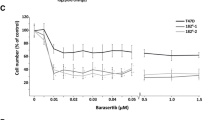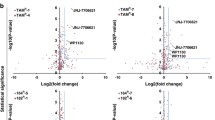Abstract
Aromatase inhibitors (AIs) are used for treatment of estrogen receptor α (ER)-positive breast cancer; however, resistance is a major obstacle for optimal outcome. This preclinical study aimed at identifying potential new treatment targets in AI-resistant breast cancer cells. Parental MCF-7 breast cancer cells and four newly established cell lines, resistant to the AIs exemestane or letrozole, were used for a functional kinase inhibitor screen. A library comprising 195 different compounds was tested for preferential growth inhibition of AI-resistant cell lines. Selected targets were validated by analysis of cell growth, cell cycle phase distribution, protein expression, and subcellular localization. We identified 24 compounds, including several inhibitors of Aurora kinases e.g., JNJ-7706621 and barasertib. Protein expression of Aurora kinase A and B was found upregulated in AI-resistant cells compared with MCF-7, and knockdown studies showed that Aurora kinase A was essential for AI-resistant cell growth. In AI-resistant cell lines, the clinically relevant Aurora kinase inhibitors alisertib and danusertib blocked cell cycle progression at the G2/M phase, interfered with chromosome alignment and spindle pole formation, and resulted in preferential growth inhibition compared with parental MCF-7 cells. Even further growth inhibition was obtained when combining the Aurora kinase inhibitors with the antiestrogen fulvestrant. Our study is the first to demonstrate that Aurora kinase A and B may be treatment targets in AI-resistant cells, and our data suggest that therapy targeting both ER and Aurora kinases may be a potent treatment strategy for overcoming AI resistance in breast cancer.







Similar content being viewed by others
References
Chumsri S, Howes T, Bao T, Sabnis G, Brodie A (2011) Aromatase, aromatase inhibitors, and breast cancer. J Steroid Biochem Mol Biol 125(1–2):13–22
Ghosh D, Griswold J, Erman M, Pangborn W (2009) Structural basis for androgen specificity and oestrogen synthesis in human aromatase. Nature 457(7226):219–223
Chan CM, Martin LA, Johnston SR, Ali S, Dowsett M (2002) Molecular changes associated with the acquisition of oestrogen hypersensitivity in MCF-7 breast cancer cells on long-term oestrogen deprivation. J Steroid Biochem Mol Biol 81(4–5):333–341
Kazi AA, Gilani RA, Schech AJ, Chumsri S, Sabnis G, Shah P, Goloubeva O, Kronsberg S, Brodie AH (2014) Nonhypoxic regulation and role of hypoxia-inducible factor 1 in aromatase inhibitor resistant breast cancer. Breast Cancer Res 16(1):R15
Masri S, Phung S, Wang X, Wu X, Yuan YC, Wagman L, Chen S (2008) Genome-wide analysis of aromatase inhibitor-resistant, tamoxifen-resistant, and long-term estrogen-deprived cells reveals a role for estrogen receptor. Cancer Res 68(12):4910–4918
Liu S, Meng X, Chen H, Liu W, Miller T, Murph M, Lu Y, Zhang F, Gagea M, Arteaga CL, Mills GB, Meric-Bernstam F, Gonzalez-Angulo AM (2014) Targeting tyrosine-kinases and estrogen receptor abrogates resistance to endocrine therapy in breast cancer. Oncotarget 5(19):9049–9064
Beaver JA, Park BH (2012) The BOLERO-2 trial: the addition of everolimus to exemestane in the treatment of postmenopausal hormone receptor-positive advanced breast cancer. Future Oncol 8(6):651–657
Dar AA, Goff LW, Majid S, Berlin J, El-Rifai W (2010) Aurora kinase inhibitors–rising stars in cancer therapeutics? Mol Cancer Ther 9(2):268–278
Goldenson B, Crispino JD (2014) The aurora kinases in cell cycle and leukemia. Oncogene. doi:10.1038/onc.2014.14
Nair JS, Ho AL, Tse AN, Coward J, Cheema H, Ambrosini G, Keen N, Schwartz GK (2009) Aurora B kinase regulates the postmitotic endoreduplication checkpoint via phosphorylation of the retinoblastoma protein at serine 780. Mol Biol Cell 20(8):2218–2228
Vader G, Lens SMA (2008) The Aurora kinase family in cell division and cancer. Biochim Biophys Acta 1786(1):60–72
Thrane S, Pedersen AM, Thomsen MBH, Kirkegaard T, Rasmussen BB, Duun-Henriksen AK, Lænkholm AV, Bak M, Lykkesfeldt AE, Yde CW (2014) A kinase inhibitor screen identifies Mcl-1 and Aurora kinase A as novel treatment targets in anti-estrogen-resistant breast cancer cells. Oncogene. doi:10.1038/onc.2014.351
Sonne-Hansen K, Lykkesfeldt AE (2005) Endogenous aromatization of testosterone results in growth stimulation of the human MCF-7 breast cancer cell line. J Steroid Biochem Mol Biol 93(1):25–34
Hole S, Pedersen AM, Hansen SK, Lundqvist J, Yde CW, Lykkesfeldt AE (2015) New cell culture model for aromatase inhibitor-resistant breast cancer shows sensitivity to fulvestrant treatment and cross-resistance between letrozole and exemestane. Int J Oncol. doi:10.3892/ijo.2015.2850
Briand P, Lykkesfeldt AE (1984) Effect of estrogen and antiestrogen on the human breast cancer cell-line MCF-7 adapted to growth at low serum concentration. Cancer Res 44(3):1114–1119
Lykkesfeldt AE, Madsen MW, Briand P (1994) Altered expression of estrogen-regulated genes in a tamoxifen-resistant and ICI 164,384 and ICI 182,780 sensitive human breast cancer cell line, MCF-7/TAMR-1. Cancer Res 54(6):1587–1597
Lundholt BK, Briand P, Lykkesfeldt AE (2001) Growth inhibition and growth stimulation by estradiol of estrogen receptor transfected human breast epithelial cell lines involve different pathways. Breast Cancer Res Treat 67(3):199–214
Pedersen AM, Thrane S, Lykkesfeldt AE, Yde CW (2014) Sorafenib and nilotinib resensitize tamoxifen resistant breast cancer cells to tamoxifen treatment via estrogen receptor alpha. Int J Oncol 45(5):2167–2175
Yde CW, Olsen BB, Meek D, Watanabe N, Guerra B (2008) The regulatory beta-subunit of protein kinase CK2 regulates cell-cycle progression at the onset of mitosis. Oncogene 27(37):4986–4997
Gully CP, Zhang F, Chen J, Yeung JA, Velazquez-Torres G, Wang E, Yeung SC, Lee MH (2010) Antineoplastic effects of an Aurora B kinase inhibitor in breast cancer. Mol Cancer 9:42
Manfredi MG, Ecsedy JA, Chakravarty A, Silverman L, Zhang M, Hoar KM, Stroud SG, Chen W, Shinde V, Huck JJ, Wysong DR, Janowick DA, Hyer ML, Leroy PJ, Gershman RE, Silva MD, Germanos MS, Bolen JB, Claiborne CF, Sells TB (2011) Characterization of Alisertib (MLN8237), an investigational small-molecule inhibitor of aurora A kinase using novel in vivo pharmacodynamic assays. Clin Cancer Res 17(24):7614–7624
Carpinelli P, Ceruti R, Giorgini ML, Cappella P, Gianellini L, Croci V, Degrassi A, Texido G, Rocchetti M, Vianello P, Rusconi L, Storici P, Zugnoni P, Arrigoni C, Soncini C, Alli C, Patton V, Marsiglio A, Ballinari D, Pesenti E, Fancelli D, Moll J (2007) PHA-739358, a potent inhibitor of Aurora kinases with a selective target inhibition profile relevant to cancer. Mol Cancer Ther 6(12 Pt 1):3158–3168
Scrittori L, Skoufias DA, Hans F, Gerson V, Sassone-Corsi P, Dimitrov S, Margolis RL (2005) A small C-terminal sequence of Aurora B is responsible for localization and function. Mol Biol Cell 16(1):292–305
Lonning PE, Eikesdal HP (2013) Aromatase inhibition 2013: clinical state of the art and questions that remain to be solved. Endocr Relat Cancer 20(4):R183–R201
Zheng XQ, Guo JP, Yang H, Kanai M, He LL, Li YY, Koomen JM, Minton S, Gao M, Ren XB, Coppola D, Cheng JQ (2013) Aurora-A is a determinant of tamoxifen sensitivity through phosphorylation of ERalpha in breast cancer. Oncogene. doi:10.1038/onc.2013.444
Thrane S, Lykkesfeldt AE, Larsen MS, Sorensen BS, Yde CW (2013) Estrogen receptor alpha is the major driving factor for growth in tamoxifen-resistant breast cancer and supported by HER/ERK signaling. Breast Cancer Res Treat 139(1):71–80
Miller TW, Balko JM, Fox EM, Ghazoui Z, Dunbier A, Anderson H, Dowsett M, Jiang A, Smith RA, Maira SM, Manning HC, Gonzalez-Angulo AM, Mills GB, Higham C, Chanthaphaychith S, Kuba MG, Miller WR, Shyr Y, Arteaga CL (2011) ERalpha-dependent E2F transcription can mediate resistance to estrogen deprivation in human breast cancer. Cancer Discov 1(4):338–351
Acknowledgments
We would like to thank Birgit Reiter for excellent technical assistance and Dr. Monika Marine Mortensen for help with FACS analysis. This work was supported by Grants from the Danish Cancer Society, Danish Cancer Research Foundation, Astrid Thaysen’s Foundation, Wedell-Wedellsborg’s Foundation, Harboe Foundation, and A Race Against Breast Cancer.
Conflict of interest
The authors declare that they have no conflict of interest.
Author information
Authors and Affiliations
Corresponding author
Additional information
Stine Hole and Astrid M. Pedersen have contributed equally to this work.
Electronic supplementary material
Below is the link to the electronic supplementary material. Online Resource 1. Data for hits identified in the kinase inhibitor screen. Triplicate samples of parental MCF-7 cells and AI-resistant cells (LetR-1, LetR-3, ExeR-1 and ExeR-3) were treated with 1.0 µM of the indicated kinase inhibitors for five days. The effect of each compound was determined by a cell viability assay. Hits were defined as compounds exerting at least two-fold statistically significant growth inhibition of one or more AI-resistant cell line compared with MCF-7 cells (indicated in red for the individual cell lines). Inhibitory effect (± SD) and P-values are shown.Online Resource 2. Cell division defects induced by barasertib. a) MCF-7, LetR-1, and ExeR-1 were treated for 48 days with 0.1 % DMSO or 0.05 µM barasertib, and cell cycle analyses were done by flow cytometry. Gating of single cells was done, and the DNA content was measured as the intensity of the propidium iodide signal. Percentage of cells with > 4 N DNA content was quantified using FlowJo Software and indicated in the figure. b ) Upon treatment of cells for 96 h with 0.1 % DMSO or 0.05 µM barasertib, 1 μg/ml Hoechst 33342 was added to the medium and fluorescence pictures of live cells were captured using an Olympus IX71 microscope. Scale bar; 10 µm.Online Resource 3. Dose – response growth experiments with MCF - 7 and AI - resistant cell lines with AI in the presence and absence of JNJ - 7706621 or alisertib. Aromatase inhibitor was withdrawn from the medium of the resistant cell lines one week before start of the experiment. MCF-7, LetR-1, and ExeR-1 cells were treated with increasing concentrations of letrozole or exemestane as indicated with or without a) 0.5 μM JNJ-7706621 or b) 0.05 µM alisertib. Cell number was determined after five days by a colorimetric assay and expressed as percentage of the control cells (0.1 % EtOH treated). Error bars represent SD of the mean of at least three replicate values. Asterisks (*) indicate significant growth inhibition compared with cells grown without aromatase inhibitor (p < 0.05).
Rights and permissions
About this article
Cite this article
Hole, S., Pedersen, A.M., Lykkesfeldt, A.E. et al. Aurora kinase A and B as new treatment targets in aromatase inhibitor-resistant breast cancer cells. Breast Cancer Res Treat 149, 715–726 (2015). https://doi.org/10.1007/s10549-015-3284-8
Received:
Accepted:
Published:
Issue Date:
DOI: https://doi.org/10.1007/s10549-015-3284-8




